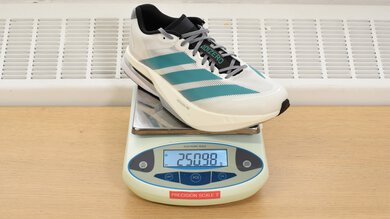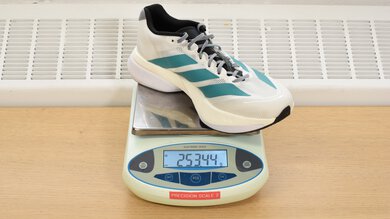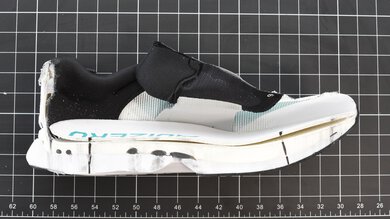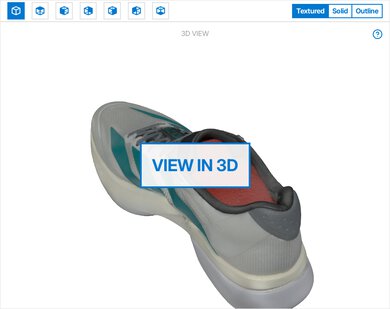The adidas Adizero Boston 13 is a plated super trainer that bridges everyday mileage and uptempo workouts. A larger slab of Lightstrike Pro sits above the updated Lightstrike carrier foam, giving the ride a noticeably livelier, slightly more forgiving feel than the adidas Adizero Boston 12 while still feeling firmly grounded and stable. Full-length ENERGYRODS add stiffness to help you pick up speed easily for tempo sessions. Thanks to a substantial weight reduction and a slightly more accommodating toebox, the Boston 13 marks a welcome update that delivers a lighter, more energetic, yet still stable experience that stays clear of today's ultra-soft trend.
Our Verdict
The adidas Adizero Boston 13 delivers decent performance for marathon racing. You won't see elite runners lacing it up at the Boston Marathon, but it still offers a reliable, stable ride that's ideal for runners who prioritize durability over cutting-edge efficiency, and still want the added stiffness of ENERGYRODS. While it doesn't have the energy return and absorption of modern super shoes, the midsole is quite energetic and offers acceptable protection (especially towards the forefoot), making it a satisfactory option for most runners. That said, the limited cushioning and firmer ride will likely make the final miles feel longer and harsher on your legs.
-
ENERGYRODS add some structural integrity.
-
Bouncy ride due to Lighstrike Pro, especially in the forefoot.
-
Stable ride due to firmer carrier foam.
-
Still a bit heavy.
-
Insufficient underfoot protection in the heel.
The adidas Adizero Boston 13 is good for shorter races, thanks to its firm, snappy forefoot, carbon rods, and good bounce, underlining its versatility across a range of paces and distances. That said, true super shoes in this category are far lighter, giving them an edge in terms of overall efficiency.
-
ENERGYRODS add some structural integrity.
-
Bouncy ride due to Lighstrike Pro, especially in the forefoot.
-
Still a bit heavy.
The adidas Adizero Boston 13 provides a nicely energetic ride, particularly in the forefoot where the larger chunk of Lightstrike Pro foam create a bouncy experience. While it's not as energetic as the heel, the forefoot still returns a lot more energy than the previous iteration, making the shoe feel efficient overall. It's a fun shoe to push the pace in, especially for tempo days and shorter efforts, giving you a sensation of controlled, predictable rebound.
-
Bouncy ride due to Lighstrike Pro, especially in the forefoot.
-
Decent bounciness in the heel.
The adidas Adizero Boston 13's cushioning is mediocre. There's more Lightstrike Pro foam in the forefoot than previous iterations, offering a bump in impact absorption and a slightly more forgiving ride that's appreciated for longer efforts. However, the heel feels noticeably underprotected compared to most super trainers, lacking that plush, marshmallow-like protection some runners might prefer.
-
Forefoot cushioning isn't too bad.
-
Insufficient underfoot protection in the heel.
The adidas Adizero Boston 13 has excellent lateral stability, helped by its structured midsole design. Whether you're pushing the pace or just logging steady miles, the combination of a firmer platform and wide base ensures a traditional, confidence-inspiring ride. It's not quite as stable as the previous version, mostly because it's narrower at the arch, but this is balanced out by a slightly wider base everywhere else. This stability is a key strength of the model, especially for runners who want a plated trainer that feels secure but is still very capable of pushing the pace.
-
ENERGYRODS add some structural integrity.
-
Stable ride due to firmer carrier foam.
- 7.2 Marathon Racing
- 8.0 5K/10K Racing
Performance Usages
- 7.6 Energy Return
- 6.2 Cushioning
- 7.6 Lateral Stability
Changelog
- Updated Jun 06, 2025: Review published.
- Updated Jun 02, 2025: Early access published.
- Updated May 09, 2025: Our testers have started testing this product.
- Updated May 09, 2025: The product has arrived in our lab, and our testers will start evaluating it soon.
- Updated May 06, 2025: We've purchased the product and are waiting for it to arrive in our lab.
Differences Between Sizes And Variants
We tested the adidas Adizero Boston 13 in men's US size 9, as noted on the label for our pair. The color shown here is Cloud White/Pure Teal/Grey. This model is also available in other colorways, including Cloud White/Core Black/Lucid Red and Core Black/Cloud White/Grey Five, as well as Cloud White/Matte Silver/Dash Grey. Wide versions are not available for this model. The design section applies only to the exact model we tested, but we expect other size and gender variants to perform similarly.
Compared To Other Running Shoes
The adidas Adizero Boston 13 sits squarely in the super trainer category, offering a ride that's ideal for runners who prefer a traditional, grounded feel rather than max softness. While many of today's top super trainers lean into maximum cushioning and soft foam bounciness, the Boston 13 delivers a firmer, more connected ride that rewards good mechanics and purposeful turnover. Its dual-density midsole—featuring a top layer of Lightstrike Pro for some bounce and a stabilizing Lightstrike carrier underneath—makes it a great choice for speed workouts and tempo efforts. Sure, you can also take it for daily miles, but it won't be the most forgiving option for that purpose. Compared to peers like the HOKA Mach X 2, PUMA Deviate NITRO 3, or Saucony Endorphin Speed 4, the Boston 13 is the firmest option—better suited to runners who prefer some structure and snappiness in order to efficiently gain speed or who find high-stack soft foams too unstable.
The Boston 13 replaces the adidas Adizero Boston 12 and brings clear improvements for most runners. Weight savings, improved energy return, and a better overall fit are all key updates that make it a more refined option overall within the super trainer game. If you're a runner who wants to build speed and strength the old-fashioned way, the Boston 13 is a dependable partner.
Within the adidas premium Adizero lineup, the Boston 13 fills a key gap between the lightweight Adizero Evo SL (which is an unplated uptempo trainer with top softness, protection, and bounciness) and their flagship super shoe (the Adizero Adios Pro 4, which is a pure race-day tool). The Boston 13 shares the ENERGYRODS found in the Adios Pro 4, but its geometry and midsole are tuned for durability and versatility, making it the "do-it-all" trainer for runners who want one shoe that can handle steady runs, speed sessions, and even occasional amateur races. While the Evo SL is more fun and playful, the Boston 13 is the more reliable workhorse, particularly for runners who appreciate a firm, confidence-inspiring platform.
For more options, check out our recommendations for the best running shoes, as well as the best running shoes for men and the best running shoes for women.
The adidas Adizero Boston 13 and adidas Adizero Evo SL may sit side by side in the Adizero lineup, but they occupy very different spaces. The Evo SL is an uptempo trainer that's unplated (apart from a partial plastic shank), making it a playful option for steady miles. Its midsole is full Lightstrike Pro, giving it a softer, more cushioned, and more energetic feel underfoot—perfect for runners who want a forgiving, bouncy ride that's smooth and fun. In contrast, the Boston 13 is a super trainer that brings a firmer, more controlled experience to the table. Its dual-density midsole combines Lightstrike Pro with a stabilizing Lightstrike carrier foam. The full-length ENERGYRODS on the Boston add noticeable stiffness and snap, giving it the kind of firm, quick turnover that suits structured speed sessions or marathon-pace efforts for runners who like a classic responsive feel that's also very stable.
The adidas Adizero Boston 13 and adidas Adizero Boston 12 are close siblings, but the 13 refines the formula in ways that make it more approachable and enjoyable for a broader range of runners. Both share the same fundamental super trainer DNA—a dual-density midsole with Lightstrike Pro on top and a stabilizing Lightstrike carrier underneath, combined with the ENERGYRODS—but the Boston 13 brings notable updates that smooth out the ride. The extra Lightstrike Pro in the forefoot doesn't make it much softer overall, but it does a better job of absorbing impact, offering a touch more cushioning without losing the snappy, connected feel the line is known for. Combined with improved energy return and a more accommodating fit, the Boston 13 feels less harsh and more fun to run in, especially when you're holding marathon pace. That said, the Boston 12 is more stable laterally, making it a better option for those who put stability at the top of their priority list.
The Saucony Endorphin Speed 4 and adidas Adizero Boston 13 are both versatile, plated trainers that can handle everything from steady daily miles to faster workouts, but they lean into slightly different strengths. The Saucony is lighter and more energetic, featuring a softer, more cushioned heel and a more bouncy feel. Its plastic plate is a bit less stiff than the adidas' ENERGYRODS. The Boston 13, on the other hand, is built for those who prefer a firmer feel in the heel and a more connected ride overall. It's also slightly heavier than the Saucony, so overall, the Saucony is the better performer in most use cases, while the Boston 13 offers a classic, workhorse feel that's great for runners who want a firmer, more focused ride during tempo efforts.
The Brooks Hyperion Max 2 and adidas Adizero Boston 13 are both plated super trainers with the ability to handle faster efforts, but they achieve it in different ways. The Hyperion Max 2 absorbs more energy with each foot strike, delivering a softer and more forgiving ride that's ideal for runners who want a shoe that can eat up long miles without feeling harsh. It also has a nylon plate, while the adidas features full-length ENERGYRODS that are stiffer. The Boston 13 is also lighter and has a more energetic midsole, making it the more efficient and lively option for runners looking to rip apart those uptempo workouts.
Test Results
The adidas Adizero Boston 13 is noticeably lighter than its predecessor, giving it better efficiency. However, it's still heavier than other super trainers like the Saucony Endorphin Speed 4 and Hoka Mach X 2, so it might not feel as effortless for extended race paces. Still, the weight reduction is a welcome improvement that helps this shoe feel more nimble.
The arch is narrower than in the previous iteration, mainly due to a redesigned cutout that's larger and more triangular, extending through the side of the outsole. This new shape, closer to the one found on the Adizero Adios Pro 4, can reduce stability for some runners. On the flip side, the forefoot is slightly wider, providing a more grounded feel during toe-off.
The shoe runs slightly longer than the previous iteration, so you might need to double-check your sizing to get the best fit. It's also a touch roomier in the heel and forefoot, making it a bit more accommodating overall compared to the snugger adidas Adizero Boston 12. This update can be a positive for those who want a bit more breathing room up front without sacrificing too much lockdown.
The heel energy return is decent in the Adidas Boston 13. It still doesn't deliver the substantial bounce of other shoes from the German brand like the Adizero Evo SL, but there's definitely a satisfactory responsive feel in the heel that helps runners transition rapidly towards their forefoot upon each impact.
The forefoot energy return is a standout feature of the model. Thanks to the increased Lightstrike Pro up front, the shoe feels more energetic and propulsive than ever before. While it might not be the most explosive ride out there—the Saucony Endorphin Speed 4, for example, has a bit more pop—it’s still a significant upgrade that makes this shoe genuinely fun to pick up the pace in.
Heel cushioning in the shoe is marginally improved compared to the adidas Adizero Boston 12, absorbing impacts a bit more effectively, especially at lower forces like during easy runs. That said, it's still lacking and won't offer the plush, pillowy feel you might expect from some max-cushion super trainers like the HOKA Mach X 2.
Forefoot cushioning is acceptable, thanks to the large slab of Lightstrike Pro in this area. While this is noticeable and makes the shoe feel quite a bit forgiving up front, it's still relatively under-cushioned compared to more protective options like the HOKA Mach X 2, so it might feel a little harsh during longer efforts for forefoot strikers.
The shoe is very firm in the heel, making for a stable platform. However, at lower impact forces, it's a bit softer than the adidas Adizero Boston 12, but this isn't game-changing in any way. Runners looking for an ultra-soft ride for their super trainer should look elsewhere, perhaps towards the HOKA Mach X 2.
The forefoot is exceptionally firm, giving this shoe a very direct, snappy toe-off and a stable feel. This firmness is consistent across different forces, making it a standout for runners who prefer a stiff, responsive ride up front—though it might feel too harsh for those seeking a softer, more forgiving feel during longer runs.









